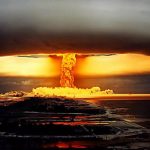Noise may not seem as harmful as the contamination of air or water, but it is a pollution problem that affects human health and can contribute to a general deterioration of environmental quality. Noise is undesirable and unwanted sound. It may be considered as music to one person and may be noise to another. Noise is defined as ‘unwanted or offensive sound that unreasonably intrude into our daily activities’. Sound is measured in a unit called the decibel (dB). The permitted noise level is 125 decibels as per the Environment Protection Rules 1999.
Sources:
There are numerous sources but may be broadly classified into two classes such as indoor and outdoor.
1) Outdoor – Industries/factories, vehicular movements such as car, motor, truck, train, tempo, motor cycle, aircrafts, trains, Construction work, defence equipments, explosions, playing of loudspeakers during various festivals etc. The higher the speed of an air craft the greater the noise pollution. The invention of supersonic air craft has added more noise for the persons who live near aerodromes. Another source of noise pollution connected with aeroplanes has been scaring away of birds. Satellites are projected into space with the help of high explosive rockets also contributes to noise pollution.
2) Indoor – Loudly played radio or music systems, and other electronic gadgets etc.
Effects of noise pollution:
· Emotional or psychological effects – irritability, anxiety and stress. Lack of concentration and mental fatigue are significant health effects of noise.
· It has been observed that the performance of school children is poor in comprehension tasks when schools are situated in busy areas of a city and suffer from noise pollution – disturbance.
· Interferes with normal auditory communication, it may mask auditory warning signals and hence increases the rate of accidents especially in industries.
· The effects can range in severity from being extremely annoying to being extremely painful and hazardous Lowers workers efficiency and productivity and higher accident rates on the job.
· Effects of Noise Pollution on Physical Health:
· Physical damage to the ear and the temporary hearing loss often called a temporary threshold shift (TTS). People suffering from this condition will be unable to detect weak sounds. However, hearing ability is usually recovered within a month of exposure. Permanent loss, usually called Noise Induced Permanent Threshold Shift (NIPTS) represents a loss of hearing ability from which there is no recovery. Below sound level of 80 dB. hearing loss does not occur at all. However temporary effects are noticed at sound levels between 80 and 130 dB to about 50 percent of the people
Source of Noise pollution
Exposed to 95 dB sound levels at work will develop NIPTS and most people exposed to more than 105 dB will experience permanent hearing loss. A sound level of 150 dB or more can physically rupture the human eardrum and >180dB can kill a person.
· In additions to hearing losses, excessive sound levels can cause harmful effect on the circulatory system by raising blood pressure and altering pulse rates.
Noise control techniques: There are 4 fundamental ways in which noise can be
controlled. 1) Reduce noise at the source 2) block the path of noise 3) increase the path length and 4) protect the recipient.
Reduce noise at the source
1. Make sure that all openings are acoustically sealed. Noise, rushes out through any cracks or openings. Muffling vehicles and machinery to reduce the noise.
2. In industries, different types of absorptive material can be used to control interior noise. Noise reduction can be done by using rigid sealed enclosures around machinery lined with acoustic absorbing material. Isolating machines and their enclosures from the floor using special spring mounts or absorbent mounts and pads and using flexible couplings for interior pipelines also contribute to reducing noise pollution at the source
3. Regular and thorough maintenance of operating machinery. We should reduce mechanical run out of shafts. By reducing this source of vibration excitation many components like bearing gears and cans may generate less noise and have generate life. We must improve lubrications. We should install bearings correctly. Improper installation sometimes is the reason for bearing noise problems
4. Traffic volume and speed also have significant effects on the overall sound. Ex: doubling the speed increases the sound levels by about 9 dB and doubling the traffic volume (number of vehicles per hour) increases sound levels by about 3 dB. A smooth flow of traffic causes less noise than a stop-and-go traffic pattern. Thus proper highway planning and design are essential for controlling traffic noise.
5. Establishing lower speed limits for highways that pass through residential areas, limiting traffic volume and providing alternative routes for truck traffic are effective noise control measures.
6. Using efficient flow techniques: for reducing noise associated with high fluid velocities and turbulence.
7. Reducing fluid jet velocities: As jet noise is proportional to the eight power of jet velocity
Block the path of noise:
Through construction of temporary/permanent barriers
1. Planting of trees around houses can also act as effective noise barriers.
2. Highly absorptive interior finish material for walls, ceilings and floors can decrease indoor noise levels significantly.
Increasing the path length: Increasing distance from the noise source and the recipient offers a passive means of control.
1. Municipal land- use ordinances pertaining to the location of airports make use of the attenuating effect of distance on sound levels.
Protect the recipient
1.Use of earplugs and earmuffs. Specially designed earmuffs can reduce the sound level reaching the eardrum by as much as 40 dB.
Besides these in general making Legislation, Educating and bringing awareness in the people is common for control of any pollution Ex: Ban on loud speakers from 10pm to 6am.
Case study: Noise Hits Whales in Hong Kong Studies have shown that shipping traffic in Hong Kong, which is one of the busiest ports in the world with approximately half a million oceanic vessels traveling through its waters every year (including over 10,000 transits by high speed ferries) has caused changes in the dolphin and whale behavior especially in response to fast moving vessels. A special sanctuary was established by the Hong Kong government in 1995, surrounding the islands of Sha Chau and Lung Kwu Chau, an important place occupied by the humpback dolphins. At any given time approximately 200 vessels surrounds this sanctuary. The sanctuary was a measure to mitigate boat traffic and tremendous noise produced. Adjacent to the sanctuary is an airport, where 700 planes descend and take off everyday, directly over the sanctuary. All the above activities have caused high noise input into the natural whale habitat. Noise, a major anthropogenic stress factor has caused a general decline in the whale populations. (Ref: .Sushmitha Baskar and Baskar)


